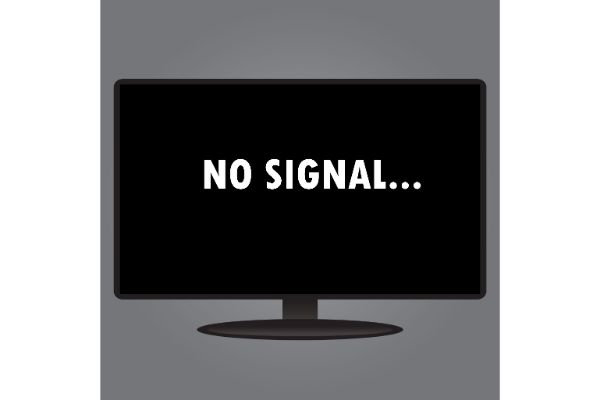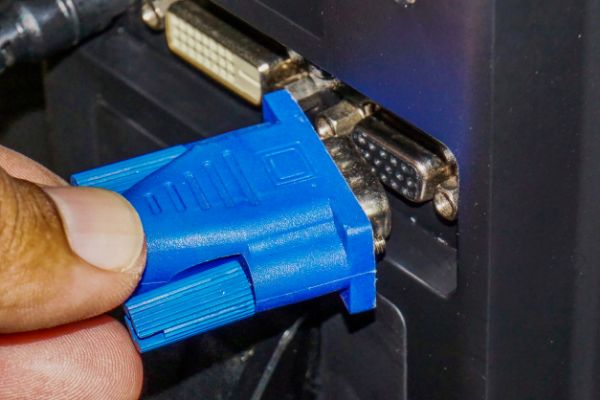Disclaimer: This post may contain affiliate links, meaning we get a small commission if you make a purchase through our links, at no cost to you. For more information, please visit our Disclaimer Page.
Dell monitors displays the “No Signal” error if the connected computer isn’t sending any video output. You can solve this problem by changing the cables, resetting the monitor resolution, or updating your graphics drivers. Consider sending the monitor back to Dell for repair if none of these works.
Table of Contents
Why Is My Dell Monitor Saying No Signal?
If your monitor keeps displaying a no signal error, don’t fret; it rarely signifies a fault from the monitor. Instead, it’s the monitor’s way to warn you that it isn’t receiving any video signals from the connected computer. Fortunately, no signal errors on Dell monitors are usually easy to fix.
Before solving your Dell Monitor’s no signal error, it’s crucial to understand the cause. When you know why it’s not receiving any signal, you can rectify the error.
Here are the possible reasons your Dell monitor may be saying “No Signal” and how to fix each error:
Faulty Cables
If your Dell monitor displays a no signal error, chances are very high that your cables are just loose. Merely unplugging the cables and reconnecting them will probably get your monitor working again. However, you shouldn’t write off the cables yet, even if that simple activity doesn’t solve the issue.
If the cables themselves don’t work, the monitor will display a no signal error, even if they fit perfectly. If unplugging and reconnecting the cables doesn’t solve the problem, try a different pair of cables.
If a new set of cables doesn’t work for you, the problem might be the port the cables connect to.
Since you can’t determine this on your own, it’s recommended to try the other fixes before inviting a repairer. Repairing the ports will cost you a little more than replacing the cables, but you won’t have a choice.
Wrong Monitor Resolution
All Dell monitors have a maximum display resolution of up to 8k. If you set the monitor to display a video greater than its resolution cap, you’ll get a no signal error. You can check the resolution settings from the settings app on your computer to reset the resolution.
To determine if the error results from setting the resolution too high, try booting in safe mode. If the monitor works fine in safe mode, you may have gotten the resolution wrong. It’s important to note that the video resolution in safe mode is usually lower than your computer’s capability.
To get the correct resolution for your monitor, consider going through the manual or updating the drivers. With the correct drivers, your monitor should default to the proper resolution automatically.
Alternatively, you can contact Dell Support with the monitor’s model number to determine its correct resolution.
Outdated Graphics Card Drivers
Since your computer’s graphics card controls all external monitors, your Dell monitor won’t work well with a faulty graphics card. If you’re changing your graphics card and your monitor simultaneously, that may likely the problem.
Newly-installed graphics cards typically require software updates to work well with your monitors. If you’re getting no-signal errors with a new graphics card, consider updating your graphics card to see if it works.
The update should usually include support for new monitors and resolutions, of which your Dell monitor might be part.
You can update your graphics card drivers from the Windows Device Manager. If you think Device Manager didn’t fetch the latest drivers, consider scanning your computer with a driver updater like DriverEasy. You can also update all your drivers by running all optional Windows updates.
Selecting the Wrong Input Source
Since a monitor typically has many input ports, you must select the correct input source to display any video. If you made the connection with VGA cables and selected HDMI as the input source, you’ll get no signal errors. It’s important to check what input source to use when connecting your monitor.
If you’re not very techy, you can seek the help of an expert with identifying the correct source. You’ll either be using a VGA, HDMI, or DisplayPort input most of the time.
The name of the cable you’re using to connect your monitor should tell you what input source to select. If you have no idea of what input source to select, you can rotate around each one.
Even if you’re getting it wrong, you’ll eventually come to the correct option. It’s not like Dell monitors typically have more than ten different input options.
Faulty Monitor
While this is rarely the problem, a fault with the monitor itself can cause the error. A faulty monitor is one of the worst-case scenarios, but it shouldn’t be a cause for alarm. If your monitor is under warranty, you can get a replacement if none of the above fixes solves the problem.
You may want to send the monitor to Dell for repair if it’s out of warranty. While it shouldn’t cost much to repair your faulty monitor, prepare to spend more than just replacing a faulty cable.
Alternatively, you can take it to an independent technician for a less reliable but likely cheaper service.
How Can I Fix No VGA Signal
A more specific version of the no signal error is the “VGA No Signal” error. If your monitor displays a VGA no signal error, it is usually because it can’t connect to a graphics card. Without the graphics card, the monitor will not display video from your computer.
VGA no signal error is pretty similar to the general no signal error on Dell monitors. They share similar causes, and you can troubleshoot them with some of the fixes provided above. However, there are specific fixes that only work with VGA no errors that you may want to try first.
Here are some fixes to try if your Dell monitor displays a no VGA signal error.
Confirm it’s not in hibernation or sleep
The primary reason your monitor displays this error is that it’s not receiving any video input from your computer. A sleeping computer can’t send any video signal, making this one of the most common causes.
If your monitor displays a VGA no signal error when you use it in clamshell mode, you’re doing it wrong. Before closing your laptop’s lid, you must set it to keep running even when the lid is closed. This should enable your computer to send video signals to your external monitor in clamshell mode.
Restart the devices
Sometimes, waking your computer up from sleep won’t automatically fix the error. Here, consider restarting the computer and reconnecting the cables to see if the issue is fixed.
Change the VGA cable
While VGA cables don’t fail frequently, they’re not failsafe. After a prolonged period of use, your VGA cable will eventually fail, requiring you to replace them. You should consider trying the cable with another computer if the no VGA signal error persists.
If the VGA cable doesn’t work, it’s usually a problem with the VGA cable. You can get a replacement cable on Amazon for a few dollars to get your monitor working again.
The monitor or VGA port is likely problematic if the cable works with another computer. Since most Dell monitors have multiple video input slots, you can try an alternate video transfer technology like HDMI. However, if none of the input slots worked, you may need to send the monitor in for repair.
It’s not recommended to keep a new monitor if the VGA port doesn’t work. Even if a feasible alternative like the HDMI port works, you’re not getting the full value for your money. If Dell can’t repair the VGA port, you should get a replacement monitor with every component working perfectly.


